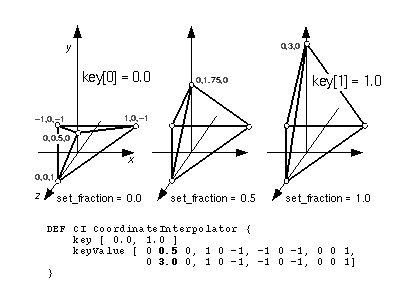|
Chapter 3:
Node Reference
Intro
Anchor
Appearance
AudioClip
Background
Billboard
Box
Collision
Color
ColorInterpolator
Cone
Coordinate
CoordinateInterpolator
Cylinder
CylinderSensor
DirectionalLight
ElevationGrid
Extrusion
Fog
FontStyle
Group
ImageTexture
IndexedFaceSet
IndexedLineSet
Inline
LOD
Material
MovieTexture
NavigationInfo
Normal
NormalInterpolator
OrientationInterpolator
PixelTexture
PlaneSensor
PointLight
PointSet
PositionInterpolator
ProximitySensor
ScalarInterpolator
Script
Shape
Sound
Sphere
SphereSensor
SpotLight
Switch
Text
TextureCoordinate
TextureTransform
TimeSensor
TouchSensor
Transform
Viewpoint
VisibilitySensor
WorldInfo
|
CoordinateInterpolator {
eventIn SFFloat set_fraction # (- , , )
exposedField MFFloat key [] # (- )
exposedField MFFloat key [] # (- , , )
exposedField MFVec3f keyValue [] # (- )
exposedField MFVec3f keyValue [] # (- , , )
eventOut MFVec3f value_changed
} )
eventOut MFVec3f value_changed
}
This node linearly interpolates among a set of MFVec3f values. The
number of coordinates in the keyValue field shall be an integer
multiple of the number of keyframes in the key field. That integer
multiple defines how many coordinates will be contained in the value_changed
events.
Section "2.6.8 Interpolators" contains
a more detailed discussion of interpolators.
| TIP:
Remember that TimeSensor outputs fraction_changed events
in the 0.0 to 1.0 range, and that interpolator nodes routed from
TimeSensors should restrict their key field values to the
0.0 to 1.0 range to match the TimeSensor output and thus produce
a full interpolation sequence. |
TECHNICAL
NOTE:
The CoordinateInterpolator was near the edge of the "cut line" for
what features should be included in VRML 2.0 and what features should
be left out. The following pros and cons influenced the decision
and should give you an idea of how decisions were made on which
features should be part of the specification.
Con: There is a strong desire to keep the VRML specification
as small as possible. A big, bloated specification is hard to implement,
hard for which to write conformance tests, takes a very long time
to create, and encourages incompatible, partial implementations.
Pro: Coordinate morphing is a feature that many people requested.
VRML 2.0 was designed "in the open." Drafts of the specification
were constantly made available on the WWW; polls were taken on general,
high-level design issues; and there were constant discussions and
debates on the www-vrml mailing list. This provided invaluable information
that helped prioritize decisions about what should be included and
excluded, and provided time for unpopular decisions to be either
justified or reversed.
Con: CoordinateInterpolator functionality can be accomplished
with a Script node. Features that are not "fundamental" (that can
be implemented using other features of the specification) were likely
to be cut.
Pro: CoordinateInterpolator calculations can require a lot
of computing power. Interpolating hundreds or thousands of coordinates
is computationally expensive compared to interpolating a single
translation or rotation. Making CoordinateInterpolator a standard
node encourages highly optimized implementations, which will be
much faster than a Script node equivalent.
Con: Implementing shapes with coordinates that may change
over time can be difficult. Many interactive rendering libraries
are optimized for the display of scenes made up of rigid-body objects,
assuming that not many objects will change shape. Changing coordinates
also requires that normals be regenerated (if explicit normals are
not specified), which is also a fairly expensive operation. Adding
CoordinateInterpolator to the specification encourages world creators
to use a feature that might result in poor performance on many machines.
In the end, the positives outweighed the negatives, but it was not
an easy decision and several other possible interpolators did not
make the cut (there is no TextureCoordinateInterpolator because
there isn't a strong enough demand for it, for example). |
EXAMPLE
(click to run):
The following example illustrates a typical use of the CoordinateInterpolator
node (see Figure 3-12). A TouchSensor is routed to a TimeSensor
that fires the CoordinateInterpolator:
#VRML V2.0 utf8
Group {
children [
DEF CI CoordinateInterpolator {
key [ 0.0, 1.0 ]
keyValue [ 1 0 -1, -1 0 -1, 0 0 1, 0 0.5 0,
keyValue [ 1 0 -1, -1 0 -1, 0 0 1, 0 3.0 0 ]
}
Shape {
geometry IndexedFaceSet {
coord DEF C Coordinate {
point [ 1 0 -1, -1 0 -1, 0 0 1, 0 0.5 0 ]
}
coordIndex [ 0 1 3 -1 1 2 3 -1 2 0 3 ]
}
appearance Appearance { material Material {} }
}
DEF T TouchSensor {} # Click to start the morph
DEF TS TimeSensor { # Drives the interpolator
cycleInterval 3.0 # 3 second morph
loop TRUE
}
Background { skyColor 1 1 1 }
]
}
ROUTE CI.value_changed TO C.point
ROUTE T.touchTime TO TS.startTime
ROUTE TS.fraction_changed TO CI.set_fraction
|

Figure 3-12: CoordinateInterpolator node
|

